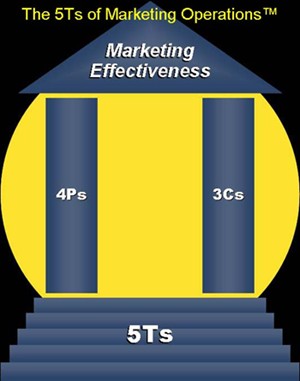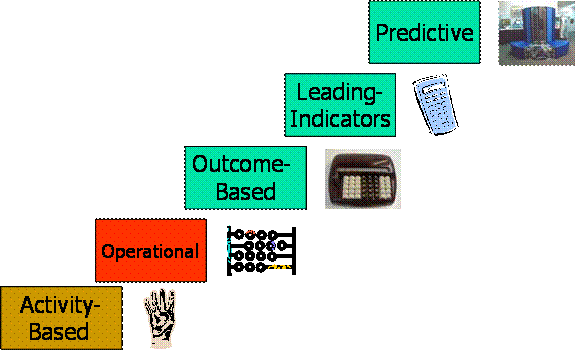by Jason McNamara
With apologies to Philip Kotler, whose four Ps—product, price, place, and promotion—have been integral to any successful product or service marketing effort of the past 50 years, today's successful marketing hinges on five new Ps.
Whereas the Ps we studied in college are all from the provider's point of view, these new Ps focus with laser-like clarity on the customer.
But customer-centricity can't be the mantra of just the marketing department. Every group, from the boardroom to product leaders to IT, must place the customer at the core of every decision it makes.
Responsibility for evangelizing within the organization rests squarely on the shoulders of the CMO. After all, if the marketing chief isn't living and breathing customer focus every minute, and encouraging others to do the same, who will believe its importance?
The CMO's office must consistently demonstrate to the rest of the enterprise the value of looking at all products, messaging, and brands through the customer's eyes. The entire organization can then get closer to the hearts and minds of their prospects and customers, with the added benefit of proving the value of every initiative that the company undertakes.
The new Ps are composed of five equally important, tightly interwoven components, designed to more tightly integrate marketing in the future.
1. People
Certainly, the audience must be at the heart of any marketing initiative. That isn't news to anyone in your department. Smart marketers have always had an instinctive sense of what their audiences would respond to. But no longer is it enough to know about your target in aggregate. Perhaps "person" might be a better heading for this P—because now it's important to know your customer intimately, as a human, emotional being.
It's one thing to know how people who generally look and act like your customer might respond. It's another to know exactly how John A. Sample has responded in the past, and what's likely to interest him next time. Why did he make his last return or exchange? What did he look at before placing an order? Has he purchased anything since his last call to customer service? What size does he wear?
Chances are, he's already told you who he is and what he wants—but were you listening?
2. Passion
Marketers are passionate about their profession. But no good marketer can function using only the right side of the brain anymore. Creativity and instinct are still important, but the anal side—the analytics side—is gaining fast.
Marketing is part of the business, and the business exists to perform. As a result, you're being held to greater accountability than ever before. Today, your passion for marketing must be driven by facts—the full view of all the data now available about customers, campaigns, and returns.
You already know that this passion for a 360-degree perspective can have an incredibly powerful effect. Being able to apply sophisticated marketing analytics to every piece of information you collect about your customers is like bringing the customers themselves in-house to tell you not just what's working and what isn't, but why. You can use this passion to your advantage, helping generate ideas, proving their relevance, and justifying the money you spend.
Still, a survey published in March by the Association of National Advertisers found that the top two concerns of senior marketing executives are integrated marketing communications and marketing accountability. Further research by the same group found that 60% of respondents had none of the necessary cross-functional involvement in their companies' development and management of marketing accountability programs to make them truly effective.
If you're like many CMOs, you've already identified the needs but may be uncertain of the solutions. Fortunately, each of these issues can be addressed by enterprisewide marketing analytics.
3. Processes
Marketing processes must become more enlightened. It's time for everyone to sing from one song sheet—instead of having discrete departments creating dissonant communications and hoarding data. Database and digital marketing, marketing operations, and customer relations all need to work in concert—a concept foreign to many companies in which other departments are often viewed as competitors rather than collaborators.
Again, the answer is a passionate, organization-wide approach to customer-centricity. If it doesn't come from the CMO, where will it begin?
Just two years ago, more than 40% of database marketers surveyed by Forrester Research lacked a complete picture of customer contact history, and one-third were missing transactional data from one or more channels.1 That is clearly less than ideal.
In an organization with customer-focused processes, everyone strides toward a common goal. In a sales organization, for example, this can mean that the group which handles generating and tracking leads works closely with the sales team to contact, close, and communicate with prospects. Everyone has a hand in determining how often to communicate, how to allocate budgets, campaign lifecycles and more.
Forrester Research analysts suggest that "socializing" the customer database is a necessary change, so that everyone in the enterprise can contribute to and benefit from this tremendous asset. It's time to throw siloed systems, ideas, and processes out the window. But a sea change like this one has to start at the top.
4. Platform
An industry of ideas, marketing also now relies heavily on technology to guide contact strategies, deliver messaging, integrate information and processes, and measure performance. This takes powerful tools, only a few of which are up to the task of managing the vast data stores available across multiple channels, but they're out there.
Of course, software and technology can't solve the issues—they can only provide the platform for coordinating and accessing information, helping to apply customer-centric thinking to every initiative an organization undertakes.
Peter Kim of Forrester Research suggests that "many brand marketers don't understand IT's value beyond email and Ethernets. Conversely, many IT departments think of marketing as the 'make it pretty' department. In the best interests of the organization, marketing and IT must come together and share resources to build an experience infrastructure layer to support the customer experience. Marketers should add a high-level internal role to champion marketing technology and to manage the construction of a marketing technology backbone."2
Of course, the internal IT department may not be the answer. They have their hands full trying to satisfy new regulatory, privacy, and security demands that crop up every day. Marketing technology, however, is a specific discipline that applies technology to traditional and emerging marketing functions that can help companies deliver consistent customer experiences, integrate marketing processes, measure performance, align themselves to the needs of their businesses, and become more accountable to senior management.
5. Partners
Partners are an integral part of marketing—they always have been and always will be. The expertise they offer adds value over and above what can be achieved in-house. Consequently, CMOs must ensure that they have solid partner relationships that are part of the process and integrated more closely into the marketing department.
As marketing becomes more sophisticated, marketing service providers, agencies, and systems integrators must all be tapped to deliver on their particular areas of expertise. It's impossible to have all the skill sets in-house and do everything well and cost efficiently.
For many companies, this isn't a new idea—they already look to different providers for various types of creative, media buying, production, and more. It just becomes more critical as highly technical capabilities come into play.
Looking to the right partners means outsourcing key responsibilities to those best equipped to deliver on them, and that reduces the risk associated with investing in new infrastructure and specialist teams.
The Five Ps in Practice
When wholly, enthusiastically deployed, the new five Ps all work together—a passion for pleasing the person with whom you're doing business gives rise to new processes, the adoption of smarter platforms and value-adding partnerships that can make the promise of one-to-one marketing real.
But it has to be an enterprisewide way of thinking that comes from the top and infiltrates every member of every team. And it has to start with you.
Sources:
1"Best Practices: Socializing The Customer Database," Forrester Research, Inc., July 23, 2007.
2"Best Practices: Customer-Centric Marketing," Forrester Research, Inc., July 25, 2007.
![]()
Jason McNamara is chief marketing officer of Alterian (www.alterian.com).

